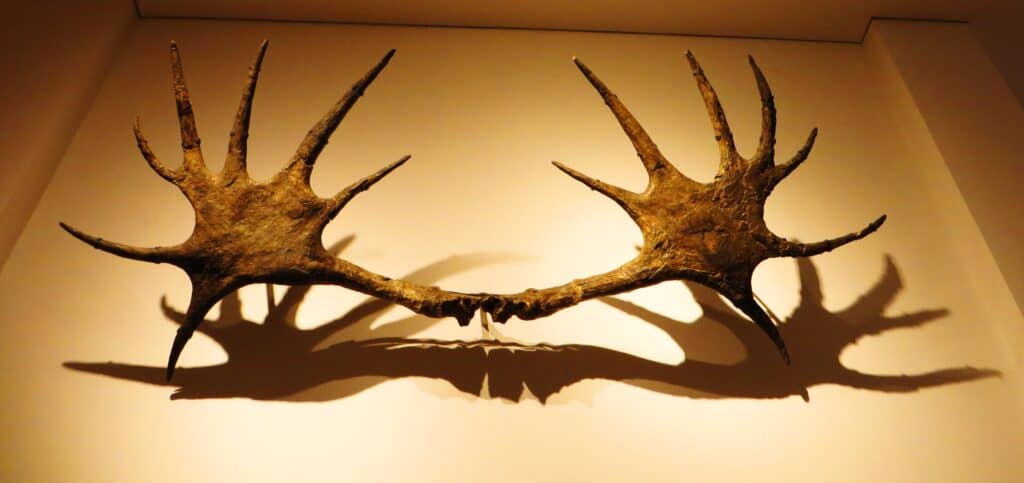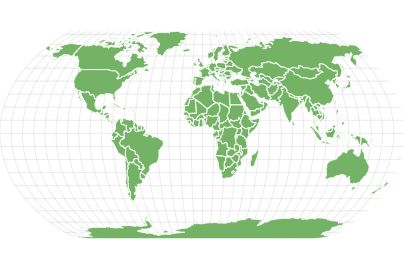Cervalces latifrons are the largest species of deer that ever existed.
Advertisement
Cervalces latifrons (Broad-Fronted Moose) Scientific Classification
- Kingdom
- Animalia
- Phylum
- Chordata
- Class
- Mammalia
- Order
- Artiodactyla
- Family
- Cervidae
- Genus
- Cervalces
- Scientific Name
- Cervalces latifrons
Read our Complete Guide to Classification of Animals.
Cervalces latifrons (Broad-Fronted Moose) Conservation Status
Cervalces latifrons (Broad-Fronted Moose) Facts
- Group Behavior
- Solitary
- Fun Fact
- Cervalces latifrons are the largest species of deer that ever existed.
- Biggest Threat
- Dire wolf, brown bears
- Most Distinctive Feature
- They had broad antlers
- Distinctive Feature
- Cervalces latifrons had a massive head
- Other Name(s)
- Broad-fronted moose, giant moose
- Habitat
- Tundra, coniferous forests, and swamps
- Predators
- Dire wolves and bears
- Diet
- Herbivore
- Lifestyle
- Solitary
- Favorite Food
- Bark, leaves, and shoots of trees like Willow, Aspen, birch, oak, and pine
- Type
- Prehistoric moose-like deer
- Common Name
- The broad-fronted moose
Cervalces latifrons (Broad-Fronted Moose) Physical Characteristics
- Skin Type
- Fur
- Weight
- 2000-2600 pounds
- Length
- 6 feet, 11 inches – 7 feet, 10 inches
- Venomous
- No
- Aggression
- Low
View all of the Cervalces latifrons (Broad-Fronted Moose) images!
Widely described as the gigantic moose, Cervalces latifrons was a deer species that lived in the Holarctic regions of Europe during the Pleistocene Period. Scientists believe it became extinct about 100,000 years ago. It is believed to be the largest species of deer that ever existed.
Description and Size

The broad-fronted moose, Cervalces latifrons, is considered the
largest deer
species ever to have existed.
©Ghedoghedo/Wikimedia Commons – License
Cervalces latifrons is the largest deer species ever known to exist. When the first description of this deer was published in 1874, the only deer genus known prior to that time was the “Cervus.” Thus, the generic name “Cervalces” was assigned in reference to that. The specific name “latifrons” means “broad front or forehead.”
Although it is commonly referred to as the broad-fronted moose or giant moose, this animal is not really a moose but a deer. As their nickname suggests, Cervalces latifrons were indeed giants, especially compared to other moose-like deers. It is estimated to have reached about 6.91 feet to 7.83 feet at the shoulder. With a mass of about 2,000 pounds, the only deer that would have come close in weight was the Cervalces scotti, and this one was up to 30% smaller. The largest members of this species might have weighed up to 2,600 pounds. This would put them in the same weight category as the modern-day American bison.
Male Cervalces latifrons had antlers mostly used for display purposes and not for fighting. Their antlers, an average of 8 feet 2 inches, were significantly smaller than other deer species like the famous Irish elk.
Their dentition was similar to that of modern moose, but theirs were much larger. They also had large lips and noses. The giant moose’s diastema was relatively shorter than that of an elk. The rest of their teeth were longer, and they had a higher jaw with additional columns on the lower molars. These helped to increase the chewing surface of the teeth.
Diet — What Did Cervalces latifrons Eat?
Cervalces latifrons was an herbivore. Experts think this animal fed on rough foliage growing around lakes and swamps. It is also likely that it had a diet of barks, leaves, and shoots of trees like willow, aspen, birch, oak, and pine. There’s also a chance this deer grazed herbaceous vegetation on valley floors.
Habitat — Where And When Did Cervalces latifrons Live?
The broad-fronted moose lived in the colder parts of Europe and Asia towards the end of the Pleistocene Epoch. It eventually crossed over into North America, where it might have evolved into the stag moose. To date, experts don’t have complete certainty as to whether it stayed in Europe, transitioned into the modern moose, or disappeared entirely after the end of the ice age. Known fossil remains are from Northern Europe and Asia.
Like its contemporary moose relations, scientists think the broad-fronted deer lived in Tundra, coniferous forests, and swamps but avoided deciduous forests due to the inconvenience that might have been caused by its wide antlers when moving through the bushes.
Experts also think they adapted to life in a marshy environment. They had long limbs that would have allowed a type of locomotion known as the “stilt-locomotion.” This motion involves a long stride with a high elevation of the feet with each step and is seen in animals that typically move through deep snow or bogs. Like modern moose, this animal was mostly solitary. Conflicts were rare since individuals stayed away from each other.
Threats and Predators
The main predators of Cervalces included grey wolves, dire wolves, and brown bears. To date, these carnivores still prey on deer and moose. Brown bears don’t hunt them actively. They tend to steal the kills of wolves or go for juvenile broad-fronted moose.
The dire wolf was much bigger than Cervalces, and as such, it would have had less trouble bringing it down as prey. American lions and Eurasian cave lions were also known to have a preference for deer-like animals.
Experts also think the first set of human hunters during the Pleistocene period were threats to Cervalces because they hunted them for food.
Discoveries and Fossils — Where It Was Found
Fossil discoveries of the giant moose are prominent in Northern Europe and Asia. This deer-like animal’s first fossil came from Norfolk and Suffolk’s coast, between Cromer and Great Yarmouth. It was discovered by Randall in 1874. The find was a frontal bone attached to part of an antler. The bones were uncovered during low tides on a beachfront.
Fossils of moose-like deer have also been found in Siberia. Although they are fragmentary and lack intact skulls or detailed antlers, they have been identified as Cervalces latifrons. Other locations where fossils of this deer have been found include France, Germany, and Italy.
Extinction — When Did Cervalces latifrons Die Out?
To date, it is still unclear as to whether this species evolved into modern times or died out completely. Some scientists, however, believe that it went due to the competition with herbivorous artiodactyls like the bison in a new grassland ecosystem that replaced the forest environment.
There is also speculation that the hunting activities of newly arrived humans contributed to their extinction. Whatever the case, Cervalces vanished towards the end of the Pleistocene about 100,000 years ago, along with many other megafaunas.
Similar Animals to the Broad-Fronted Moose
Similar animals to Cervalces latifrons include:
- Irish elk — The Irish elk is an extinct deer species in the genus Megaloceros. Like broad-fronted moose, it is one of the largest deer species that ever lived. It is also a member of the Cervidae family, with an ecological range that extends from Eurasia to Ireland.
- Cervalces scotti — This is a species similar to Cervalces latifrons. Experts believe they’re closely related, with the scotti being the North American version of the latifrons. It had complex antlers and became extinct 11,500 years ago.
- Alces alces — Also commonly referred to as the moose, The Alces are the largest and heaviest living species in the deer family. Like the Cervalcles latifrons, the moose lives a solitary life.
Related Animals
Sources
https://en.wikipedia.org/wiki/Cervalces_latifrons
https://prehistoric-fauna.com/Cervalces-latifrons
https://www.sciencedirect.com/science/article/pii/S0031018204005255
View all 235 animals that start with CCervalces latifrons (Broad-Fronted Moose) FAQs (Frequently Asked Questions)
When was Cervalces latifrons alive?
The broad-fronted moose lived in Europe and Asia during the Pleistocene poch. This species probably went extinct about 100,000 years ago, which means they were alive through the planet’s series of glaciations (the last ice age).
How big was Cervalces latifrons?
On average, the giant moose was about seven or eight feet tall and weighed 2,000 pounds. The largest members of the species might have weighed up to 2,600 pounds. This means they were thirty percent bigger than Cervalces scotti and up to two times bigger than the Irish elk.
Why did Cervalces latifrons go extinct?
They went extinct 100,000 years ago, near the end of the Pleistocene Epoch. Scientists largely differ in their opinion about its extinction. However, the most popular theories revolve around pressure from humans, habitat changes, and disease. The evolution of better-adapted herbivores might have also caused the extinction.
Thank you for reading! Have some feedback for us? Contact the AZ Animals editorial team.
Sources
- Wikipedia, Available here: https://en.wikipedia.org/wiki/Cervalces_latifrons
- Prehistoric Fauna, Available here: https://prehistoric-fauna.com/Cervalces-latifrons
- Breda, Marzia; Pini, Roberta; Ravazzi, Cesare, Available here: https://www.sciencedirect.com/science/article/pii/S0031018204005255

















